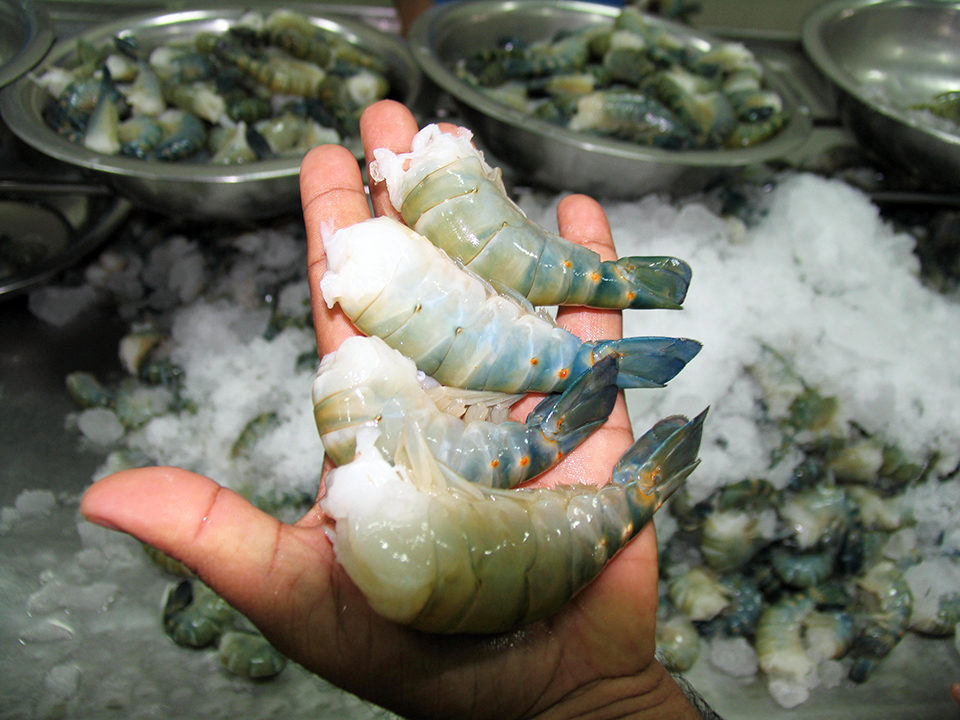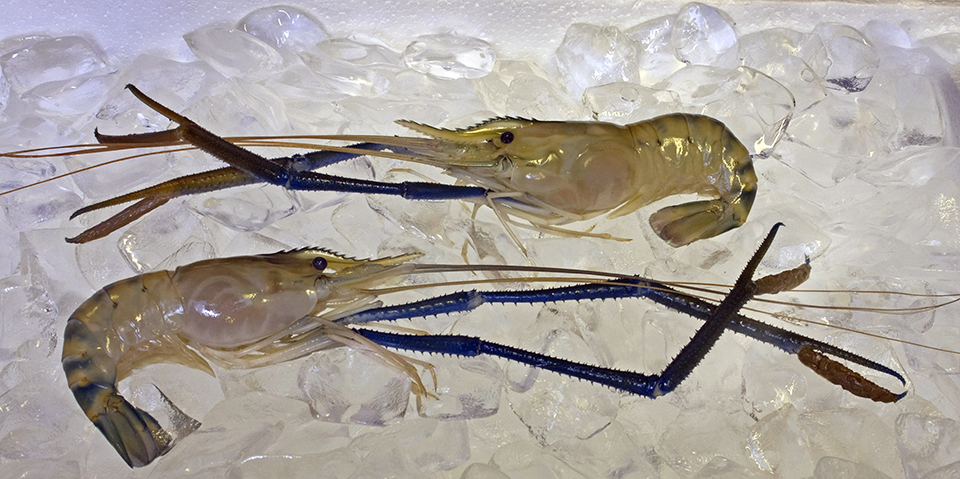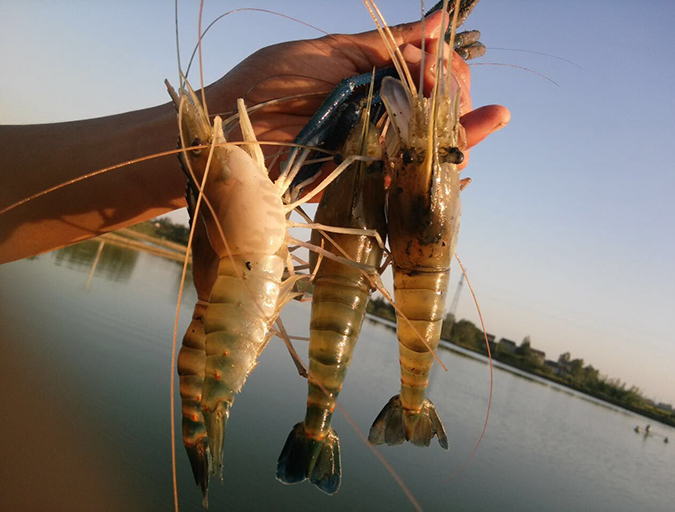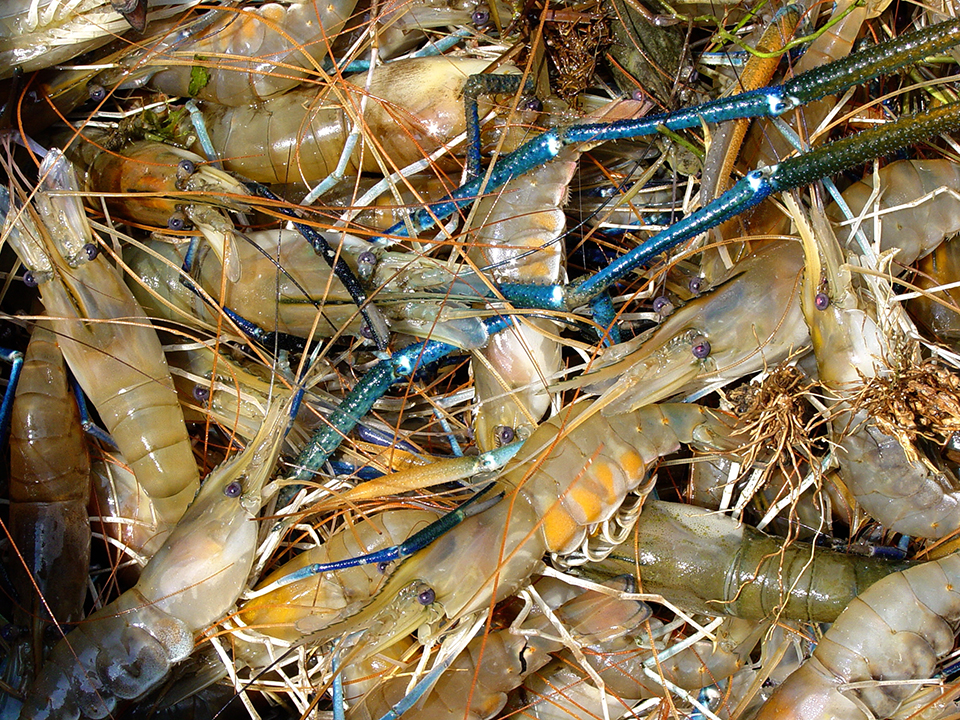Microbial composition, food safety

The freshwater shrimp (Macrobrachium rosenbergii) is a major aquaculture species due to its high fecundity, rapid growth, wide range of salinity and temperature tolerance and disease resistance, as well as its acceptable taste and high commercial value.
Possible pathogens
Farmed freshwater shrimp can contain significant pathogenic bacteria that can result in foodborne illness unless care is exercised by producers, retailers and consumers. Additionally, many of the human pathogenic bacteria can be responsible for significant mortalities in culture animals if good production management practices are not implemented.
Aeromonas
Aeromonas hydrophila, a common microorganism in pond aquaculture systems, has been reported as a cause of acute diarrheal disease, particularly in children and immunocompromised patients.
In research, four strains of A. hydrophila were grown at two temperatures in shrimp purée and two microbiological media. Results showed reduced cytotoxic and hemolytic activity for A. hydrophila in shrimp purée compared with the two media, despite increased proteolytic activity in most cases. It was suggested that shrimp protein provides some protection against the pathogen by binding with the hemolysin and protecting the erythrocytes.
Vibrio
Microbiological analyses of freshwater shrimp and growing waters have revealed the presence of several human Vibrio pathogens, particularly V. cholerae 01 and V. parahaemolyticus. In addition to being a human pathogen, V. parahaemolyticus can cause mortalities in shrimp as great as 80 percent while also causing black discoloration on the carapace, red discoloration of the exoskeleton and loss of appendages. The discoloration results in general consumer rejection of shrimp, while appendage loss is considered a quality defect by Asian customers.
There is some evidence that V. cholerae 01 occurs naturally in the environment independent of human fecal contamination. Seafood has been a major transmission vehicle for the pathogen, as cross-contamination during harvesting, processing and distribution may occur.
In a study, shrimp samples with and without the adhering carapace were heated prior to inoculating with cells of V. cholerae 01. One-half of the samples were stored frozen at -20 degrees C, and the other half were heated to boiling temperatures.
Viable cells of the test microorganism were recovered from samples without carapaces stored under frozen conditions for 36 days. In contrast, no living cells were recovered after 26 days from samples with carapaces. Boiling inactivated or destroyed V. cholerae 01 in both the samples with and without carapaces within two minutes of exposure.

Listeria
Listeria monocytogenes contamination in seafood has been implicated in several cases of listeriosis. The microorganism grows at normal refrigeration temperatures and is relatively resistant to damage due to freezing.
Several studies reported that 9 to 11 percent of shrimp samples were positive for L. monocytogenes. One study found 28 percent of raw seafood positive for the organism.
In a study, cooked, peeled and deveined shrimp were inoculated with a five-strain mixture of L. monocytogenes and packaged in air, vacuum or 100 percent carbon dioxide-modified atmosphere and then stored at 3, 7 and 12 degrees-C for 15 days. Results demonstrated that shrimp packaged in carbon dioxide and stored at 3 degrees-C did not permit growth of the microorganism during storage, while the other packaging/temperature combinations allowed multiplication of the bacterium.
Carbon dioxide packaging also resulted in the slowest growth of psychrotrophic bacteria and more acceptable sensory, odor and appearance scores at the end of storage. When strict temperature control is difficult, such as during processing, transportation, retailing or home use, additional processing controls may be necessary to ensure safety.
E. coli, salmonella
An international study was performed on aquaculture shrimp by analyzing 1,234 samples from 103 shrimp farms in six countries for the presence of fecal coliforms, Escherichia coli and Salmonella species. A significant (P = 0.0342) relationship was found between the log number of fecal bacteria and the probability that any given sample would contain Salmonella. The likelihood of a sample containing Salmonella was increased 1.2 times with each 10-fold increase in fecal coliform or E. coli concentration.
The statistical relationship among Salmonella concentrations and those of fecal coliforms and E. coli was highest in grow-out pond water. The likelihood of identifying Salmonella in grow-out water increased 2.7 times with each log increase in fecal coliform concentration and 3.0 times with each log increase in E. coli concentration.
Salmonella is not part of the natural flora of the shrimp culture environment, nor is it inherently present in shrimp ponds. The occurrence of Salmonella in shrimp from aquaculture operations is related to the concentration of fecal bacteria in the source of the grow-out water (Table 1).
Flick, Sample types and frequency of Salmonella, Table 1
| Sample Type | Number of Samples | Positives (number) | Positives (%) |
|---|---|---|---|
| Feces | 65 | 6 | 9.2 |
| Holding pond water | 40 | 1 | 2.5 |
| Other animals* | 5 | 0 | 0 |
| Pond sediment | 225 | 2 | 1.0 |
| Pond growout water | 261 | 9 | 3.5 |
| Ice | 16 | 0 | 0 |
| Processing water | 22 | 3 | 13.6 |
| Drinking water | 117 | 5 | 4.3 |
| Probiotics, fertilizer | 25 | 1 | 4.0 |
| Shrimp | 247 | 4 | 1.6 |
| Shrimp feed | 63 | 0 | 0 |
| Source sediment | 25 | 6 | 24.0 |
| Source water | 120 | 6 | 5.0 |
| Wastewater | 3 | 1 | 33.0 |
| Total | 1,234 | 44 | 3.6 |
Table 1. Sample types and frequency of Salmonella at shrimp farms.
Amines
Amines are formed during spoilage of shrimp as a result of bacterial decarboxylation of free amino acids. Both mesophilic and psychrophilic bacteria possess more than one decarboxylase enzyme. Among the amines, histamine has been most frequently implicated in food poisoning, and the diamines, primarily putrescine and cadaverine, are known to enhance histamine poisoning. Putrescine has been suggested as an index of decomposition in shrimp.
The survival of amine-forming bacteria during the ice storage of shrimp was investigated up to 14 days. The initial bacterial load was reduced one log from an initial concentration of 105 cfu/g due to cold shock. The total incidence of biogenic amine-forming bacteria was found to be 56.05 percent in shrimp.
The amine-forming bacteria identified were cadaverine- and putrescine-forming bacteria, and no histamine was detected. Gram-negative Alcaligenes, Flavobacterium, Acinetobacter, Shewanella and Pseudomonas were the predominant amine-forming bacteria. In addition, the only Gram-positive genus was Micrococcus. Aeromonas and Photobacterium were also present, and may be capable of forming amines in shrimp.
Perspectives
Growing water appears to be the greatest factor affecting the type and quantity of human pathogenic bacteria in shrimp. It is important that aquaculture producers understand the connection between fecal bacteria contamination and the likelihood of isolating human pathogens in their shrimp.
Producers should identify the potential sources of contamination that affect source water and growout pond water, and eliminate or minimize those pollution sources that are within their control. On farms using source water with high fecal coliforms or Escherichia coli concentrations, producers should consider using a holding pond to allow contaminated particulate matter to settle into the sediment.
(Editor’s Note: This article was originally published in the January/February 2011 print edition of the Global Aquaculture Advocate.)
Author
-

George J. Flick, Jr., Ph.D.
Food Science And Technology Department
Virginia Tech/Virginia Sea Grant (0418)
Blacksburg, Virginia 24061 USA[117,100,101,46,116,118,64,103,107,99,105,108,102]
Tagged With
Related Posts

Intelligence
Post-harvest quality of freshwater prawns, part 1
Spoilage in freshwater prawns is endogenous rather than exogenous and results from proteolytic enzymes in the cephalothorax.

Intelligence
Culture of giant freshwater prawns in China
Farming of giant freshwater prawns is very popular in China. The Yangtze River Delta region produces more than 60 percent of the country's output. Production increases have resulted from a novel system that involves greenhouses that allow ponds to be stocked ahead by two months.

Aquafeeds
Feeding strategy supports freshwater prawns without fishmeal, fish oil
Low-input culture practices for freshwater prawns can manage their growth and biological characteristics so they can be fed no fishmeal or fish oil.

